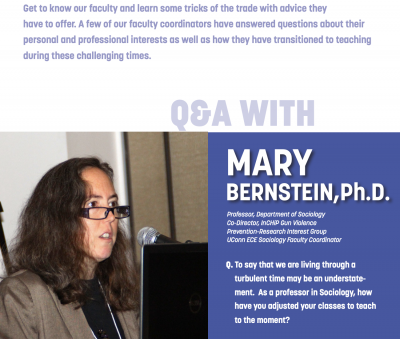By Melanie Banks
 I think that COVID-19 has really focused public attention on the collective health and mental well-being of those around us. It has also laid bare the racial and economic inequities in our society. As faculty, it is incumbent on us to help students understand the origins of these disparities in institutional racism and racist ideologies that have produced such gross inequities.
I think that COVID-19 has really focused public attention on the collective health and mental well-being of those around us. It has also laid bare the racial and economic inequities in our society. As faculty, it is incumbent on us to help students understand the origins of these disparities in institutional racism and racist ideologies that have produced such gross inequities.
A. I think we’ve had two different moments in the crisis. The first came with the abrupt lockdown when the campus community was told on Friday, March 13th that we would not to return to campus following spring break and that we were to transition our classes online. We were all scared as no one knew much about how the disease was transmitted, such as whether we could catch it from our mail or our groceries. We all know so much more now and as educators, we know that informative, concrete, empirical data is power. Science should not be political.
So, in Spring 2020, I moved my Sociology of Law class online to an asynchronous format. Since I believe that students learn best when they are engaged in thoughtful discussion, I thought that it would be harder to accomplish that goal on WebEx, so I made online-based discussion a graded requirement of the class. What I found really surprised me. First, the shyer students participated equally, and this allowed more people to engage fully in the discussion. Second, I made the discussion questions which were posted on HuskyCt very targeted, requiring close engagement with the readings. I found that in responding to my discussion prompts, students referred more closely to the readings and because everyone had to participate, they engaged more fully with the text.
I heard from many students who did not have easy access to the internet or who, because they were now living at home, had to take on more responsibility such as caring for younger siblings who were struggling to attend school online. As students reached out, I was able to make accommodations as needed. I found out that one of my advisees was living in a homeless shelter, going to the public library to take her online classes and do her homework. Together with UConn staff, we were able to find her housing and to improve her situation.
In my graduate class, we continued to meet online synchronously. We generally started each class with a check in where we learned that some of us were introverts and adapting well to the isolation, others were single parents struggling to balance work, school, and home as they took care of small children who no longer had daycare or playdates. In short, the lockdown provided more of an opportunity for us to know each other as people and to understand how the constant struggle for work-life balance affected each of us differently, and how that struggle was accentuated because of the pandemic. I think that the pandemic has provided for many of us an opportunity to practice compassion and understanding.
This fall 2020 semester, things feel a bit easier. We understand the disease better and know what we should do to keep ourselves as safe as we can be. But the struggles for students with younger siblings or family obligations or for those who have to work with the public that increases their exposure to COVID-19 continue. As a teacher and advisor, my go to question for students who are struggling, is, “What is keeping you from being able to complete assignments or keep up with your classes? Can we come up with a plan to make things easier?” This opens the dialog to greater empathy and to think through ways to support our students.
Q. Professors in the humanities and social sciences are uniquely positioned to read the news and put it in a larger context. How do you engage with the news in your classes and give structure to the moment we are living in?
A. Sociologists are uniquely positioned to place the disparate effects of the pandemic in a broader context. We can raise and discuss important questions such as why are Black, Brown, and indigenous people disproportionately affected by the pandemic and why are they dying at higher rates than their European American counterparts? Who has access to healthcare and who does not? What explains these differences? What has the pandemic taught us about how society is organized, what we would call the division of labor? After all, we depend on the people who continued to work at the grocery stores and of course all of the healthcare workers which, without them, we quite literally would not survive. Who keeps them safe? What are they paid? Why do some people react with compassion and others with fear?
Q. While you give structure and context for your students, how do you advise students who come to you confused, disaffected, and/or angry and not knowing how to make positive change?
 The unequal racial impact of the pandemic has brought the racial inequities of our society into stark relief. For many European-American people, the murder of George Floyd by police officers in Minnesota laid bare the racism embedded in the criminal justice system and sparked uprisings across the country. For Black and Brown people, the police murder of Floyd was one more example of a criminal justice system where Black and Latinx people who constitute approximately 25% of the population make up 59% of the prison population. Compared to similar nations, the U.S. incarceration rate is five to ten times higher. Understanding structural racism is a critical part of what sociologists study. With the increased organizing for racial justice, there are myriad ways for students to get involved and they can start by looking online. For those who do not feel safe protesting in person, many social movement organizations now meet online which I believe for many makes participation easier, though of course, we all miss the in person contact. Whatever issue you care about, whether it is climate change or voting rights or something else, you can find a group that is working for positive social change.
The unequal racial impact of the pandemic has brought the racial inequities of our society into stark relief. For many European-American people, the murder of George Floyd by police officers in Minnesota laid bare the racism embedded in the criminal justice system and sparked uprisings across the country. For Black and Brown people, the police murder of Floyd was one more example of a criminal justice system where Black and Latinx people who constitute approximately 25% of the population make up 59% of the prison population. Compared to similar nations, the U.S. incarceration rate is five to ten times higher. Understanding structural racism is a critical part of what sociologists study. With the increased organizing for racial justice, there are myriad ways for students to get involved and they can start by looking online. For those who do not feel safe protesting in person, many social movement organizations now meet online which I believe for many makes participation easier, though of course, we all miss the in person contact. Whatever issue you care about, whether it is climate change or voting rights or something else, you can find a group that is working for positive social change.